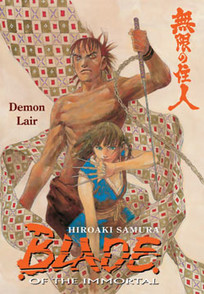Review
by Carl Kimlinger,Blade of the Immortal
GN 20-21 - Demon Lair/Demon Lair II
| Synopsis: |  |
||
Chained in an underground dungeon and subject to the cruel whims of doctor Burando, the mad medic in charge of the Shogunate's immortality experiments, Manji's final hope lies with Rin, who along with Itto-ryo swordswoman Doa, has infiltrated the dank maze of tunnels in which Manji is being held. With a combination of blind luck and quick thinking Rin finally reaches Manji's cell, but before she can free him the masterminds behind his plight are upon them. With one free leg, one free arm, and an assortment of makeshift weapons, Manji sets about making his tormentors regret that they ever dared dream of stealing his immortality. |
|||
| Review: | |||
In many ways the Prison arc is the pinnacle of Hiroaki Samura's attempt to push Blade of the Immortal past mere samurai action into the realm of pure art. From its anti-dramatic structure to its role reversals (Rin does the rescuing) and increasingly sophisticated pencil art, his ambition informs every aspect of the story. The punked-out excess of early Immortal has been traded in for careful, Kurosawa-styled humanism and political insight, and the plot has the simplicity of a darkly relevant fable. Even as the arc delves deep into action territory, its fights remain rooted in the intricacies and strategies of real-life swordplay in a way that recalls the artful minimalism and studied realism of Lone Wolf and Cub as much as it does the gonzo bloodletting of early Immortal. You can almost taste the series' thirst for respectability. But the obviousness of the series' intent doesn't lessen its effectiveness. The Immortal on display here is controlled and insightful. Its slow-burning narrative heats incrementally to a raging climax, even as it explores timely ideas about medical testing and the military application of medical technology. Its vision of the horrors unleashed by a government that has gained possession of a living key to immortality is frighteningly plausible and thoroughly nauseating. This is probably the most focused and mature the series has ever been. More importantly, though, it doesn't let its ambitions get in the way of serving up a monstrous payoff. Which is where these two volumes come in. Over the course of nearly five-hundred pages Manji's cell becomes an ever-shifting battlefield in which every humiliation, indignity and atrocity is paid back to the roster of slimy villains threefold. Burando, Habaki, Asaemon: Manji and Rin (and a few others) are unleashed on each in turn in a series of thrillingly improvisational fights. It's a veritable orgy of catharsis, only surpassed in its power to satisfy by the unutterably fulfilling moments during which Manji and Rin are able to enjoy their long-belated reunion. And the agonizingly slow buildup and restrained realism only serve to make it all the sweeter. Samura's background in classical art is stamped all over his illustrations. A large part of Immortal's enjoyment is derived solely from looking at his art. His art has a somehow old-fashioned feel, a timelessness that comes from his use of pencil shading, insane amounts of detail and very un-manga-like representational realism. His drawings look as if they could have come from an old Sherlock Holmes serial—only sequenced into fast-paced action scenes full of dismemberment and general mayhem the likes of which would have made Arthur Conan Doyle toss his cookies. You wouldn't call Samura's art pretty, but it is beautiful, full of relevant details and complex textures, and informed with a knowledge of the human body and its articulation that many manga lack. Few manga are such a pleasure simply to look at, much less to read. If there's a flaw to his artistry, it's that actions can sometimes be lost in the rush of details. Occasionally his art doesn't flow the way it should, but that's less an issue with Samura's artistry than his decision to resequence his art in Western format by cutting and pasting the panels in reverse order. The editors warn at the beginning of each volume that the process can cause issues with continuity, and they're right. Not lethal issues, but niggling little ones that can cause you to briefly lose your place in action sequences. For the most part original sound effects are replaced with well-integrated English sound effects. A glossary of terms is included at the end of each book, and volume 21 also features a fake news article that paints Samura as an evil, drug-addled hack. It takes a brave or an ambitious artist to stick their main character in a dungeon for an entire story arc. If anyone was wondering whether the reward for watching Manji get dissected for four volumes was worth all the restless waiting, it is. This two-volume battle royale is everything one could ask for in a climax: violent, smart and brimming with gory schadenfruede. It even avoids the sadistic sexual violence that marred earlier climaxes and manages to work in a few granules of understated manly romance. Sure the series' ambitions adorn its every move, but ambitions are only a problem if they haven't the muscle to back them up. And if there's anything that Blade of the Immortal has plenty of, it's muscle. |
| Grade: | |||
|
Overall : B+
Story : B+
Art : A-
+ Hard-hitting, satisfying climax to the series' most accomplished arc to date. |
|||
| discuss this in the forum (1 post) | | |||
| Production Info: | ||
|
Full encyclopedia details about Release information about |
||